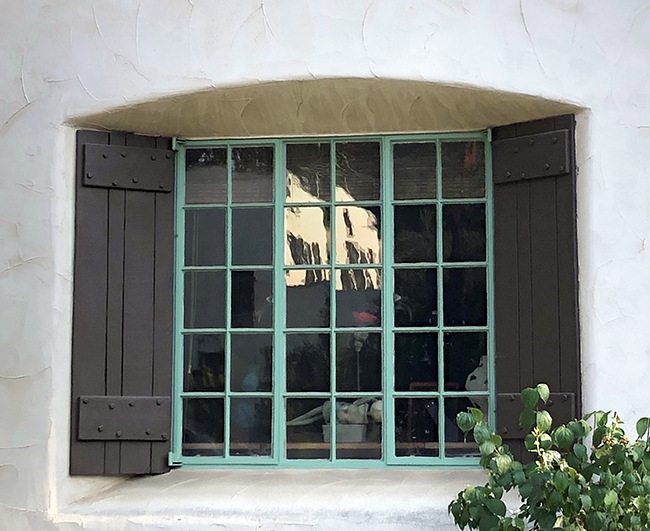Restore, don’t replace windows

Metal casement windows like this one on a Spanish Revival house on Sixth Street are a character defining feature and can be restored. Photo/courtesy of John Neiuber
by John Neiuber | Special to the Courier
Windows are one of the character defining features of older homes. Replacing the windows will alter the historic fabric of the home and change the look of the house, which, in turn, can affect the value and appeal of the property.
However, those new double-paned windows that are “maintenance free” and that pop up on your social media feed, and are the subject of door hanger ads left by solicitors are enticing. And if you can receive rebates and other credits, why not?
In summer and winter, energy moves through the walls, roof, and cracks of your home. Windows and doors account for 20% of all your energy loss, according to the majority of experts. Walls account for about 15%, the ceiling about 10%, floors and below grade space about 20%. Infiltration and air leakage account for the most at around 35%.
Homeowners often spend their dollars first on insulation and windows when weatherizing. But these aren’t the best and most cost-effective investments to begin with. Reducing air leaks is a much less costly investment and should be undertaken first. Then, combining the insulation values for walls, ceilings, and floors will take care of 25% to 45% of energy loss.
A study published by The National Park Service’s National Center for Preservation Technology and Training analyzed decades of research. It showed a number of retrofit strategies for windows come very close to the energy benefits of high performance replacement windows and at a fraction of the cost. Findings showed that replacement windows are the most expensive option, double that of common retrofits.

This wood double-hung window in the columnist’s home is 116 years old and has been maintained using restoration techniques. Photo/courtesy of John Neiuber
One of the biggest myths about replacement windows is that they will save you money. Properly installed high quality replacement windows might save you about $100 a month on your heating and cooling bills. Let’s say you spend $16,000 to install new windows, and you heat and cool the home an average of nine months for a savings of about $900 a year. At this rate, it would take 18 years to recoup the amount spent on the new windows. The typical replacement window often fails within 10 to 20 years depending on quality. This means that in the time it would take to recoup the original investment, the replacement windows may have to be replaced at least once.
Among the other myths about replacement windows is that they are guaranteed and maintenance free. Many window replacement companies guarantee you will save 40% on your heating and cooling costs. If you read the fine print, it states that if you don’t save that 40%, the maximum refund is as low as $500.
Many replacement windows come with “limited lifetime warrantees.” Read the fine print again: Most warrantee the glass for 20 years, installation for two years and the other components for 10 years. The “lifetime” in the guarantee describes the lifetime of the product, not the lifetime of your home. The maintenance free claim is made mostly by those companies selling vinyl and aluminum windows. In reality, these windows cannot be maintained, repaired, or painted. If a part fails, or the insulated glass breaks or the vinyl warps, the entire window must be replaced.

The bay window on this Village Craftsman house features old growth wood that will last many lifetimes if properly maintained. Photo/courtesy of John Neiuber
Another myth surrounding replacement windows is that they are the environmentally responsible choice. To determine the total environmental impact of a replacement window, one needs to take into consideration the embodied energy of the new and existing windows, the impact of manufacturing new products, and the expected lifecycle of the product. Embodied energy includes the energy expended to produce the raw materials, to transport them, to make them into a new product, to ship the product, and to install the product. Demolishing historic windows wastes embodied energy and requires additional energy to remove and dispose of them.
Considering the carbon footprint to produce a new window and the loss of embodied energy if existing windows are removed and discarded clearly demonstrates the advantages of retrofit strategies for existing windows.
Chances are the windows in your house are one of the features that define its character, style of architecture, and charm. The old windows are built with high-quality materials such as old growth wood that can last for hundreds of years if maintained properly. Those old windows were built to fit their openings and can be repaired. Old windows perform well and can be just as energy efficient as new ones. If you are concerned about energy efficiency and about preservation, they need not be mutually exclusive. You can preserve your windows and you can be energy efficient at the same time. Restore, not replace.
1 Comment
Submit a Comment
You must be logged in to post a comment.









Agree 100%. Personally, I think the green tint is very distracting on an older home.